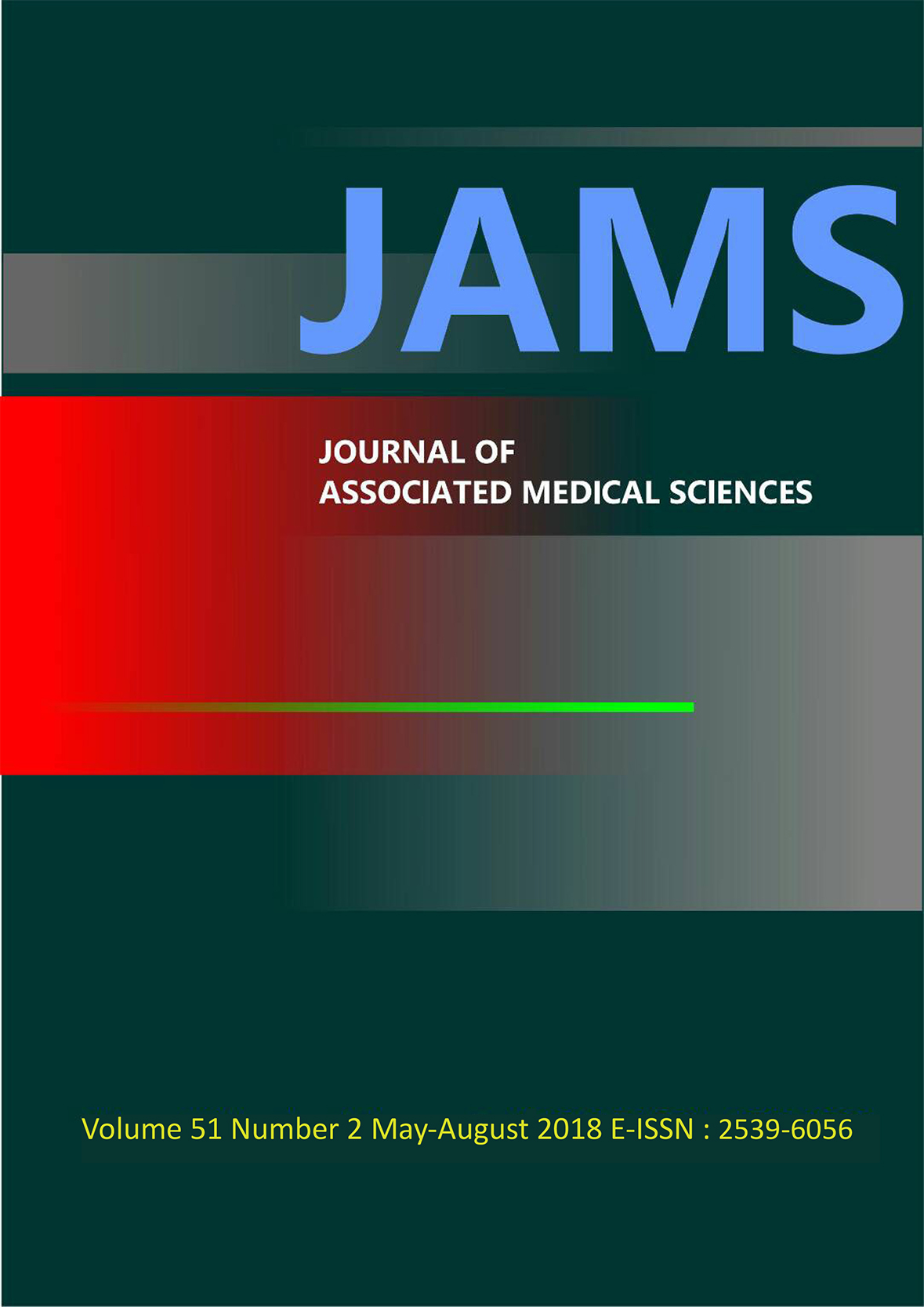Immediate and short-term effects of thoracic manipulation with neck muscles stretching compared with neck muscles stretching on alteration of pain and range of motion in mechanical neck pain
Main Article Content
Abstract
Background: Mechanical neck pain is generally found among manual workers. Manual therapy is one of treatment for patients with neck pain. Alternatively, thoracic spine thrust manipulation may efficiently treat mechanical neck pain. Therefore, treatment using biomechanical connection between cervical and thoracic spine can increase joint mobility for improvement of neck disorders.
Objectives: To investigate the immediate effects of post-test (48-72 hours and short-term 2 weeks follow up) of thoracic manipulation in combination with stretching exercise on mechanical neck pain, pressure pain threshold, Neck Disability Index (NDI), forward head posture, and cervical range of motion.
Materials and methods: Forty patients with neck pain were recruited in the study. Participants were divided into four groups: (1) thoracic manipulation; (2) thoracic manipulation with stretching exercise; (3) stretching exercise; and (4) control.
Results: There was a statistically significant difference between outcomes of the groups. Thoracic manipulation with stretching exercise group had better results than that of manipulation, stretching group, and control group on visual analog pain scale. Statistically significant difference was found when its effect was to the stretching and control group on NDI and pressure pain threshold. Thoracic manipulation with stretching exercise group had a statistically significant difference when compared to stretching, control group on forward head posture, and cervical range of motion in extension direction.
Conclusion: Thoracic manipulation may be an alternative treatment in mechanical neck pain in producing more benefits when is used in combination with stretching exercise to decrease neck pain, increase cervical range of motion, and tends to neutralize head posture decreasing neck disability.
Article Details

This work is licensed under a Creative Commons Attribution-NonCommercial-NoDerivatives 4.0 International License.
Personal views expressed by the contributors in their articles are not necessarily those of the Journal of Associated Medical Sciences, Faculty of Associated Medical Sciences, Chiang Mai University.
References
[2] Guide to Physical Therapist Practice. 2nd ed. American Physical Therapy Association. Phys Ther: 2001. 81(1): 9-746.
[3] Dunning JR, Cleland JA, Waldrop MA, et al. Up¬per cervical and upper thoracic thrust manipu¬lation versus nonthrust mobilization in patients with mechanical neck pain: a multicenter randomized clinical trial. J Orthop Sports Phys Ther 2012; 42: 5-18.
[4] Binder AI. Cervical spondylosis and neck pain. BMJ 2007; 334: 527-31.
[5] Erhard R. The Spinal Exercise Handbook. A Home Exercise Manual for a Managed Care Environment. Pittsburgh PA: Laurel Concepts, 1998.
[6] Gummesson C, Isacsson SO, Isacsson AH, et al. The transition of reported pain in different body regions: a one-year follow-up study. BMC Musculoskelet Disord 2006; 7: 17.
[7] Jull G, Trott P, Potter H, et al. A randomized controlled trial of exercise and manipulative therapy for cervicogenic headache. Spine (Phila Pa 1976) 2002; 27: 1835-43.
[8] Gross A, Miller J, D’Sylva J et al. Manipulation or mobilisation for neck pain. Cochrane Data¬base: Syst Rev, 2010.
[9] Fernandez de las Penasc, Fernandez-Carnero J, Plaza Ferna´ndez A, et al. Dorsal manipulation in whiplash injury treatment: a randomized controlled trial. Journal of Whiplash and Related Disorders 2004; 3: 55-72.
[10] Cleland J, Childs M, McRae M, Palmer J, Stowell T. Immediate effects of thoracic manipulation in patients with neck pain: a randomized clinical trial. Manual Therapy 2005; 10: 127-35.
[11] Lau MCH, Chiu TW, Lam TH. Clinical measurement of craniovertebral angle by electronic head posture instrument: a test of reliability and validity. Manual Therapy 2009; 14: 363-8.
[12] Cleland JA, Glynn P, Whitman JM, Eberhart SL, Macdonald C, Childs JD. Short-term effects of thrust vs. nonthrust mobilization/manipulation directed at the thoracic spine in patients with neck pain: A randomized clinical trial. Phys Ther 2007; 87: 431-40.
[13] Weerasirirat P, Puntumethakul R, Chatchawan U, Arayawichanon P. Comparison of immediate effects between multiple thoracic manipulation and single thoracic manipulation in chronic mechanical neck pain: a pilot study of randomized controlled trial. J Med Tech Phy Ther 2012; 24(2): 208-19.
[14] Lau MCH, Chiu TW, Lam TH. The effectiveness of thoracic manipulation on patients with chronic mechanical neck pain - A randomized controlled trial. Manual Therapy 2011; 16: 141-47.
[15] Norlander S, Aste-Norlander U, Nordgram B, Sahlstedt B. Mobility in the cervico-thoracic motion segment: an indicative factor of musculoskeletal neck-shoulder pain. Scandinavian Journal of Rehabilitation Medicine 1996; 28:183–92.
[16] Norlander S, Gustavsson BG, Lindell J, Nordgren B. Reduced mobility in the cervico-thoracic motion segment-a risk factor for musculoskeletal neck-shoulder pain: a two-year prospective follow-up study. Scandinavian Journal of Rehabilitation Medicine 1997; 29: 167-74.


